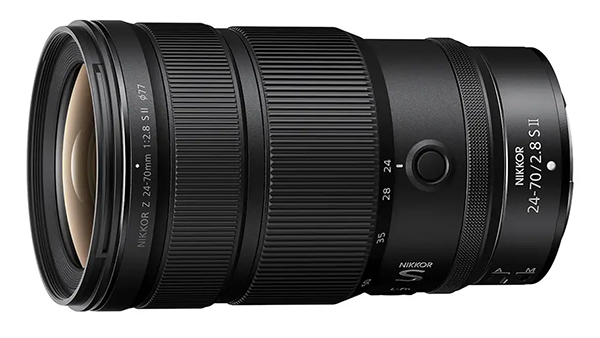Nikon has announced the impending release of the second-generation model for its popular Nikkor Z 24-70mm f/2.8 S lens, which features a new internal zoom mechanism and faster autofocusing.

Angled view of the Nikkor Z 24-70mm f/2.8 S II lens, shown without end caps and lens hood. (Source: Nikon.)
Designed for full-frame Z-mount cameras, the new lens is the first in its class with an internal zoom mechanism and, at approximately 675 grams, is also the lightest in its class. The internal zoom mechanism increases zooming stability and dust- and drip-resistant performance. It features a multi-focusing system, based upon a Silky Swift VCM (SSVCM) drive and a guide mechanism developed by Nikon. This is the first time this mechanism has been used in a zoom lens and it achieves a winning combination of extremely precise and quiet AF for both still-image and video recording. The new lens supports a minimum focus distance of 24 cm at the wide-angle end and 33 cm at the telephoto end of the zoom range. Maximum reproduction ratio is 0.21x at the wide-angle end and 0.32x at the telephoto end.
The optical design of the new lens contains 14 elements in 10 groups and including three aspherical elements and two ED elements. The adoption of a large-diameter double-sided aspherical lens for the front lens element and effective arrangement of ED glass and aspherical lens elements have achieved both a lightweight design and the highest level of image quality in the S-Line lens series. This arrangement also suppresses focus breathing. Application of Meso Amorphous Coat ensures the best anti-reflection performance in Nikon history, while ARNEO Coat effectively suppresses ghosting and flare. A newly developed 11-blade diaphragm enables very rounded bokeh. The control ring includes a clicking switch that allows the user to enable and disable the tactile “click” of control ring operation. The supplied lens hood has a filter adjustment window that allows users to adjust circular polarising and variable ND filters without removing it. Other changes include a duplicated lens function button, with one accessible in portrait orientation and the other in landscape mode.
Local release date and pricing information has yet to be released but overseas websites are stating the lens will be available in mid-September at an MSRP of US$2599. Click here for more information.






